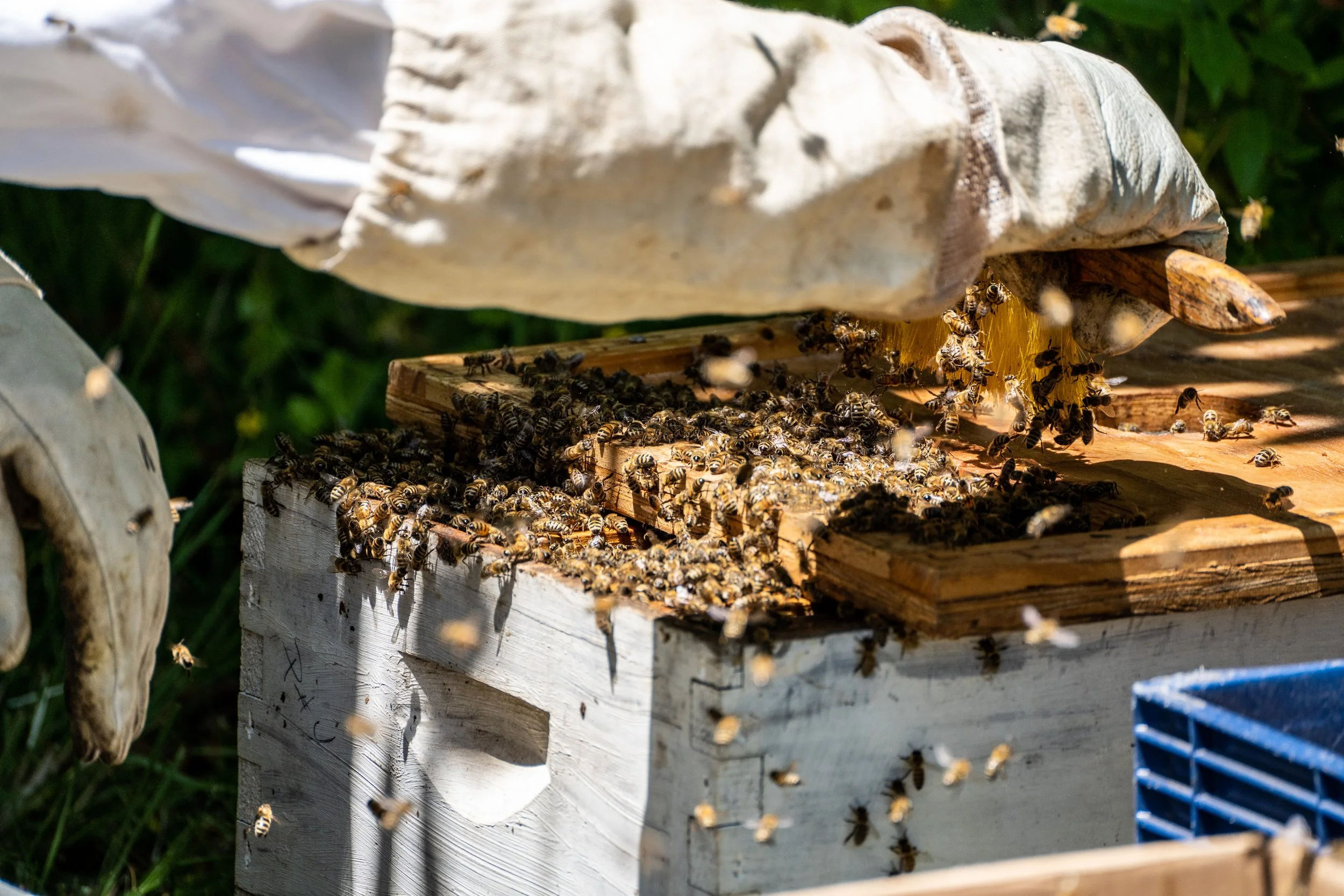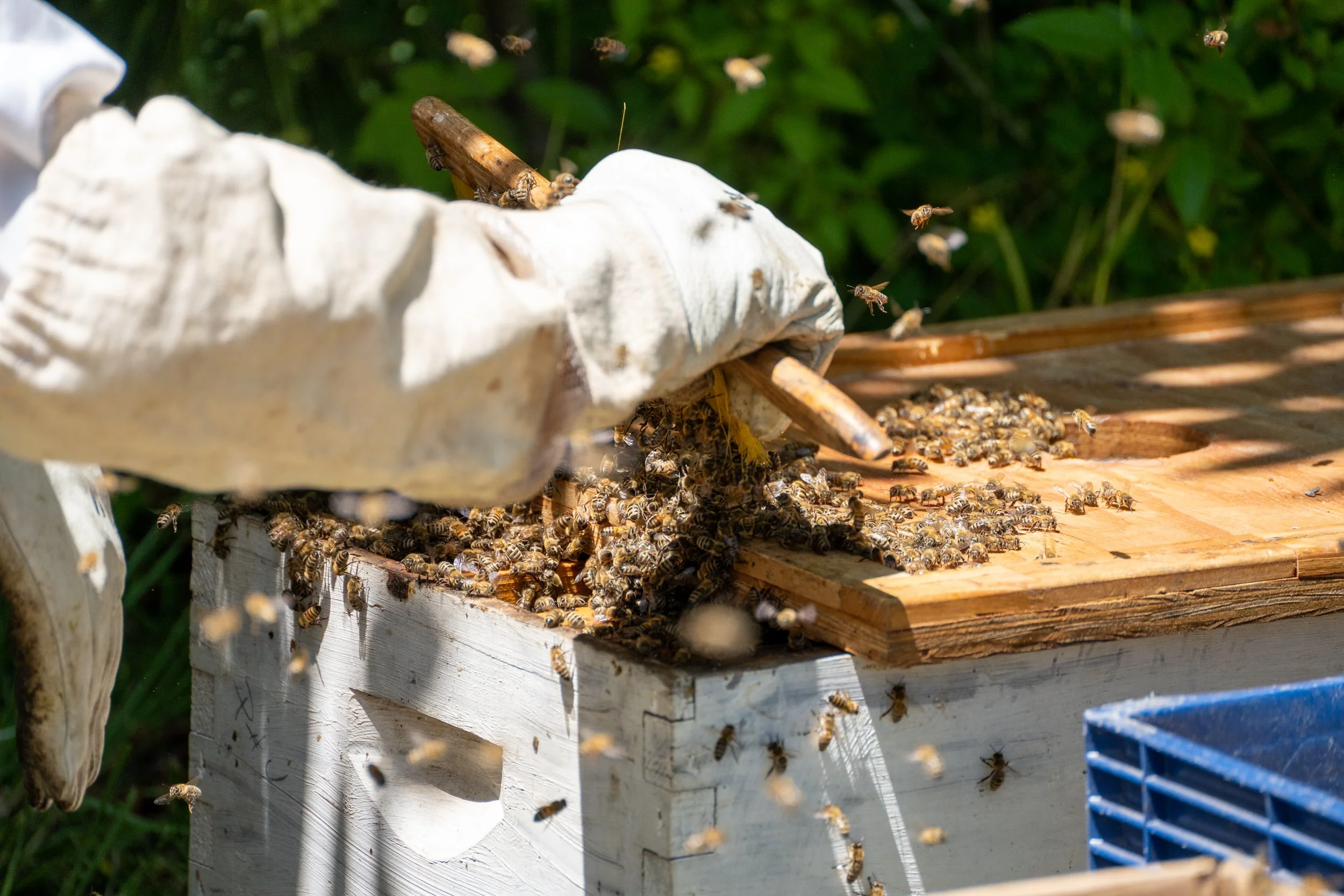The Buzzzzzzzz
The hum of bees is the voice of the garden
Elizabeth Lawrence (the internationally renown garden writer, not the actress from All My Children)
I recently had the opportunity to see a honey bee swarm up-close. Well, as close as I was willing to get — I used my telephoto lens. At all times. I was not actually close at all… I did get closer than everyone else in the house, though. Wusses.
The swarm showed up in a tree in the back garden of Bob’s daughter’s house. The first photo below was when I first saw the bees. It was evening, so a) the light was not very good for photos and b) the bees were quiescent. I noticed that they were almost all facing up with their wings spread out.
The second photo was the next morning when the bees were far more “busy.” I had done a bit of bee research (including talking to a beekeeping friend), and knew that there were scouts out looking for a permanent home. I could see that some of the bees were doing a “waggle dance” to let the rest of the swarm know that they thought they had found somewhere suitable. According to the Wikipedia article about swarming honey bees, the swarm waits until there is a quorum of about 80 percent of the 20 to 50 scout bees before making the decision to move into the new home.
Bob’s daughter managed to contact a local beekeeper from the county beekeeper association’s “swarm hotline” and Bernie and his border collie showed up within an hour. He had to arrive quickly, because apparently swarms don’t always hang around very long and the entire swarm will suddenly leave all at once - as soon as the scout bees have reached a quorum. As they are looking for a fairly large, but enclosed place with a small opening, this is often in someone’s wall or chimney. The border collie stayed in the truck. Border collies can do a lot of things, but herding honey bees isn’t one of them.
Bernie got to work quickly, lit his bee smoker and started collecting as many of the bees as possible into a cardboard box. He then gently shook the box and swept the bees into a wooden beehive box he had brought with him and carefully slid the lid mostly closed. He was hoping to get the queen into the box so the rest of the bees would stay.
Bee Collection
Bee Smoker
One of the bees picked up the leaf and flew away with it. No leaves allowed!
As he did not actually see the queen, he sat and watched the bees in the box for a few minutes. He was looking for bees sticking their butts in the air and fanning the queen pheromones out to attract the rest of the swarm. This, of course, would only happen if the queen was actually in there.
He went back up in the tree several times to collect more bees. He said they weren’t very aggressive because they only had their minds on one thing, and that was the queen. I could see that - in the photos below, you can see the flying bees buzzing around Bernie’s head are almost all facing the swarm. They certainly weren’t interested in me.
Bernie was a font of bee information and obviously LOVED bees. Once he had most of the hive in the wooden beehive, he said that they would almost immediately start foraging because they would be in a home. They did. They all of a sudden they weren’t all facing away from me, but many were flying towards me and buzzing me (ok, maybe two or three, but it seemed like a lot). I beat a hasty retreat.
Once he had collected a box full of bees from the tree, Bernie shook them out of the box onto the hive and then very gently swept them toward the opening where they could detect the queen.
As usual, click the photos below to enlarge and see the caption:
Bernie left the hive there for the rest of the day and came back at dusk to collect the hive once all the bees had returned “home” from foraging so he wouldn’t leave any stragglers.
Honey bees have been “domesticated” for possibly over 8000 years (there are differences of opinion by experts in this matter). “Domesticated” might be a misnomer - humans have learned how to manage them and give them houses that they like to use, which not coincidentally make it easier for us to exploit them for their honey as is explained in this article.* It seems to be a mutually beneficial symbiotic relationship.
A swarm of bees in May
is worth a load of hay,
A swarm of bees in June
is worth a silver spoon,
But a swarm of bees in July
is not worth a fly.
Author Unknown
Since these bees showed up on the last day in May and were picked up the first day in June, they were worth somewhere between a load of hay and a silver spoon.
*Hirst, K. Kris. "History of the Human Management of Honey Bees." ThoughtCo, Apr. 5, 2023, thoughtco.com/history-honey-bees-and-human-management-171271.
Subscribe to my blog!












